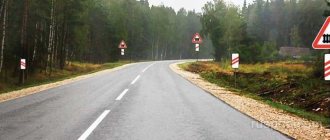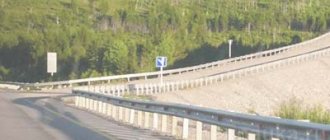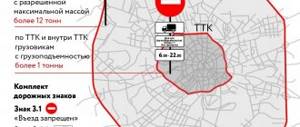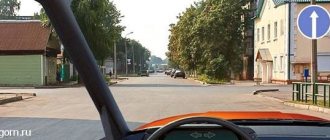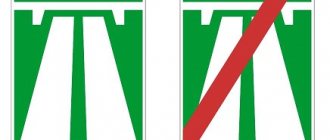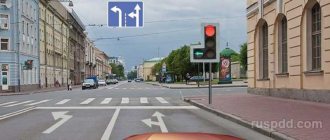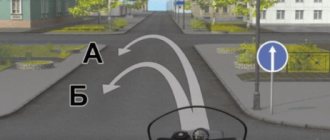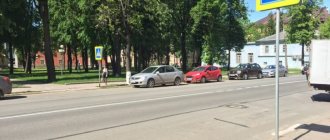In this part, we briefly note the general Rules for cyclists.
Traffic lights
6.5. If a traffic light signal is made in the form of a silhouette of a pedestrian (bicycle), then its effect applies only to pedestrians (cyclists). In this case, the green signal allows, and the red signal prohibits, the movement of pedestrians (cyclists).
To regulate the movement of cyclists, a traffic light with round signals of reduced size can also be used, supplemented by a rectangular white plate measuring 200 x 200 mm with a picture of a black bicycle.
Maneuvering signals
8.1. Before starting to move, change lanes, turn (U-turn) and stop, the driver is required to give signals with light direction indicators in the appropriate direction, and if they are missing or faulty - with his hand
. When performing a maneuver, there should be no danger to traffic or interference with other road users.
The signal for a left turn (turn) corresponds to the left arm extended to the side or the right arm extended to the side and bent at the elbow at a right angle upward. The right turn signal corresponds to the right arm extended to the side or the left arm extended to the side and bent at the elbow at a right angle upward. The brake signal is given by raising your left or right hand.
8.2. The turn signal or hand signal must be given well in advance of the maneuver and cease immediately after completion (the hand signal may be terminated immediately before the maneuver). In this case, the signal should not mislead other road users.
Lighting devices
19.1. In the dark and in conditions of insufficient visibility, regardless of the road lighting, as well as in tunnels, the following lighting devices must be turned on on a moving vehicle:
- on all motor vehicles and mopeds - high or low beam headlights, on bicycles - headlights or lanterns
, on horse-drawn carts - lanterns (if equipped);- on trailers and towed motor vehicles - side lights.
What is the maximum speed of a cyclist?
The maximum speed of a cyclist is limited to the same extent as for other vehicles. In the city it is prohibited to exceed the established limit of 60 km/h; in courtyards and residential areas the permitted speed is no more than 20 km/h. Cyclists are required to comply with speed limit road signs.
In addition, a cyclist can reach a speed above 25 km/h only using his own strength, since in accordance with the definition of “Bicycle”, the speed developed by a bicycle electric motor cannot exceed 25 km/h.
Position of cyclists on the road
Requirements for the movement of cyclists are set out in a special chapter of the Rules of the Road - “24. Additional requirements for the movement of cyclists and moped drivers.” This part requires special attention.
For cyclists over 14 years of age
24.1. Cyclists over 14 years of age must use bicycle paths, bicycle pedestrian paths, or bicycle lanes.
Important. This paragraph establishes the obligation for cyclists over 14 years of age to move on a specially designated section of the road, if available. Driving on other elements of the road is prohibited.
All subsequent paragraphs establishing a different location of cyclists on the road are
a sequence of exceptions from the first paragraph
.
Driving on the right edge of the roadway
The first exception is that cyclists are allowed to ride on the right edge of the roadway
- in the following cases:
- there are no bicycle and bicycle pedestrian paths, a lane for cyclists, or there is no opportunity to move along them;
- the overall width of the bicycle, its trailer or the cargo being transported exceeds 1 m;
- cyclists move in columns;
And so, if there is no special designated section of the road for the movement of bicycles, the cyclist must first move along the right edge of the roadway.
Driving on the side of the road
The second exception is driving on the side of the road.
:
- if there are no bicycle paths, bicycle pedestrian paths, or a lane for cyclists, or there is no opportunity to move along them or along the right edge of the roadway;
Driving on a sidewalk or pedestrian path
Third exception - on a sidewalk or pedestrian path
:
- there are no bicycle and bicycle pedestrian paths, a lane for cyclists, or there is no opportunity to move along them, as well as along the right edge of the roadway or shoulder;
- a cyclist accompanies a cyclist under 7 years of age or transports a child under 7 years of age on an additional seat, in a bicycle stroller or in a trailer designed for use with a bicycle.
As you can see, driving on a sidewalk or pedestrian path is an extreme case for cyclists. Be careful and follow this sequence when identifying a road element for cycling.
For cyclists aged 7 to 14 years
24.3. The movement of cyclists aged 7 to 14 years should be carried out only on sidewalks, pedestrian, bicycle and pedestrian paths, as well as within pedestrian zones.
Cyclists under 14 years of age are prohibited from riding on the roadway or shoulder.
For cyclists under 7 years of age
24.4. Cyclists under 7 years of age should only ride on sidewalks, pedestrian and bicycle paths (on the pedestrian side), as well as within pedestrian zones.
Cyclists under 7 years of age must ride on a section of road designated for pedestrian traffic.
Rules for the movement of cyclists on the roadway
24.5. When cyclists move along the right edge of the roadway in the cases provided for by these Rules, cyclists must move only in one row
.
A column of cyclists may move in two rows if the overall width of the bicycles does not exceed 0.75 m
.
The column of cyclists must be divided into groups of 10 cyclists
in the case of single-row traffic or in groups of 10 pairs in the case of double-lane traffic.
To facilitate overtaking, the distance between groups should be 80 - 100 m
.
Rules for the movement of cyclists on the sidewalk and pedestrian areas
24.6. If the movement of a cyclist on a sidewalk, pedestrian path, shoulder or within pedestrian zones endangers or interferes with the movement of other persons, the cyclist must dismount and follow the requirements provided for by these Rules for the movement of pedestrians.
On the sidewalk, pedestrians and others have full priority over cyclists. This also applies to crossing roads and crossing exits from adjacent areas when a cyclist is moving on the sidewalk.
Cyclists are prohibited
- drive a bicycle or moped without holding the handlebars with at least one hand;
- transport cargo that protrudes beyond the dimensions by more than 0.5 m in length or width, or cargo that interferes with control;
- transport passengers if this is not provided for by the design of the vehicle;
- transport children under 7 years of age in the absence of specially equipped places for them;
- turn left or turn around on roads with tram traffic and on roads with more than one lane for traffic in a given direction;
- move on the road without a fastened motorcycle helmet (for moped drivers).
- cross the road at pedestrian crossings.
Let us highlight the prohibition of turning left on roads that have more than one lane in a given direction and the position of the cyclist in front of the turn.
Before performing the maneuver, the cyclist who is the driver must take a position.
8.5. Before turning right, left or making a U-turn, the driver must take the appropriate extreme position in advance on the roadway intended for traffic in that direction...
Another important point: cyclists are prohibited from crossing the road at pedestrian crossings. If this requirement is violated, the cyclist does not have priority in traffic.
.
Towing of bicycles and bicycles is prohibited.
24.9. Towing of bicycles and mopeds, as well as towing with bicycles and mopeds, is prohibited, except for towing a trailer intended for use with a bicycle or moped.
Driving on the highway is prohibited.
16.1. On highways it is prohibited:
- movement of pedestrians, pets, bicycles
, mopeds, tractors and self-propelled vehicles, other vehicles, the speed of which, according to technical characteristics or condition, is less than 40 km/h;
Cyclist privileges
April 15, 2015 in the Rules of the Road, allowing the movement of bicycles on a dedicated lane for route vehicles.
18.2. On roads with a lane for fixed-route vehicles, marked with signs 5.11, 5.13.1, 5.13.2, 5.14, the movement and stopping of other vehicles is prohibited (except for school buses and vehicles used as passenger taxis, as well as cyclists - in (if the lane for route vehicles is located on the right)
on this strip.
This right can only be exercised if there are no bicycle and pedestrian paths or a lane for cyclists.
Rights and responsibilities of a cyclist on the road in accordance with traffic regulations
7 minutes Author: Mikhail Skvortsov 83
A cyclist is the same driver of a vehicle as someone sitting behind the wheel of a car or motorcycle, so he must comply with the traffic rules in force in his country. This means no drinking while driving, no talking on a cell phone while driving, no turning around in solid lanes, no driving in the opposite direction on a one-way road. The main responsibilities of a cyclist are set out in a separate section of the Rules of the Road.
Will my driver's license be revoked if I'm caught riding my bike drunk?
Many cyclists mistakenly believe that riding a bicycle does not carry any responsibility. Despite the fact that regulatory authorities pay minimal attention to cyclists, the law still provides for liability for driving while intoxicated. At the beginning of the article, we noted that a bicycle is a vehicle, and a cyclist is a driver.
The rules specifically prohibit driving any vehicle while intoxicated.
2.7. The driver is prohibited from:
- drive a vehicle while intoxicated (alcohol, drugs or other), under the influence of medications that impair reaction and attention, in a sick or tired state that jeopardizes traffic safety;
Can my driving license be revoked if I'm caught riding a bicycle while drunk? Let us turn to the article of the Code of Administrative Offenses of the Russian Federation according to which drunk drivers are punished:
1. Driving a vehicle by a driver who is intoxicated, if such actions do not constitute a criminal offense, -
shall entail the imposition of an administrative fine in the amount of thirty thousand rubles with deprivation of the right to drive vehicles for a period of one and a half to two years.
At first glance, it seems that the article is entirely suitable for cyclists and employees may try to attract attention based on it. However, riding a bicycle does not require a special driving license and obtaining, as well as deprivation of, such a right has nothing to do with driving a bicycle. For cyclists, the Code of Administrative Offenses of the Russian Federation provides a special article defining liability.
Please note that if you drive a scooter or moped while intoxicated, the application of this article is completely legal. The only exception for this article is cyclists.
What are the penalties?
Article 12.29 of the Administrative Code, parts 2 and 3, states that the driver of a 2-wheeled vehicle bears administrative and financial liability for ignoring bicycle signs. The penalty is a fine of 800 rubles.
If, as a result of an unlawful action, damage was caused to the health or property of third parties, the cyclist must compensate the cost of the damage caused to the victim, and the amount of the administrative fine increases several times in relation to the original one.
Fines for cyclists
Article 12.29. Violation of the Traffic Rules by a pedestrian or other person participating in traffic
2. Violation of the Traffic Rules by a person driving a bicycle, or a driver or other person directly involved in the process of road traffic (except for the persons specified in part 1 of this article, as well as the driver of the vehicle) - eight hundred rubles
.
3. Violation of traffic rules by persons specified in part 2 of this article, committed while intoxicated, shall entail the imposition of an administrative fine in the amount of one thousand to one thousand five hundred rubles.
.
Violations of the traffic rules discussed in this article for a cyclist will cost 800 rubles, and in case of committing a violation while intoxicated, from 1000 to 1500 rubles.
The growing trend towards a healthy lifestyle is forcing car drivers to switch to a two-wheeled vehicle - a bicycle. An increase in the number of this type of transport leads to the creation or allocation of part of the highway for bicycle paths. However, to prevent their four-wheeled counterparts from crowding out their two-wheeled counterparts, there is a bicycle lane sign in front of the lane for the latter to move. Mopeds and scooters are also allowed to move along it.
A bicycle path is considered to be an independent road or part of a highway dedicated to the traffic of bicycles, scooters and mopeds. Cars, horse-drawn vehicles and pedestrians are prohibited from entering the designated lane. The latter can walk along it if there is no sidewalk, curb or pedestrian areas.
The bicycle street sign is presented in the shape of a blue circle with a white bicycle image. This road attribute belongs to the category.
International traffic agreements define a bicycle lane as a separate road or part of it dedicated to cyclists. Such zones are indicated by an appropriate road sign and are structurally separated from the roadway.
Such areas are separated from the roadway by a dividing strip, a piece of land with grass, side stones or slabs. Many European cities can boast of similar lanes, which form an entire transport network. Russian regions provide only isolated areas for two-wheeled riders, not to mention the lack of a transport network.
The presence of a bicycle lane indicates that cyclists should only ride on it. Driving onto the roadway is considered by traffic rules to be a violation of traffic regulations.
Organizing the traffic of rover-cyclists comes down to several methods.
Two-wheeled vehicles move:
- along a dedicated lane on the sidewalk;
- a separate road that is adjacent to the sidewalk or roadway;
- a designated area, isolated by natural objects and side stones.
The latter zone may be located on a road with one-way traffic on both sides. A two-way highway has the right to place only one lane on the surface for rovers, on the side where the width of the road allows. Often such sites are located on the side of the primary location of local administrative institutions, shops, and public utility facilities.
Paths for two-wheeled vehicles come in various types. There are one-way roads that border the highway on both sides. The countries of Northern Europe have a similar entire network, where the bicycle route is somewhat raised above the level of the roadway. American cyclists use single-level trails, however, they are separated from road surfaces by a parking or buffer strip.
Two-way traffic is usually found on a lane along a street or road surface. Large cities cannot allocate enough space for the mentioned riders; more often the ribbons are located in the suburbs and towns.
Joint traffic of pedestrians and bikers cannot be ruled out:
- If a highway has several secondary street connections on one side. The lanes are located on the opposite side, which ensures safety for cyclists from cars entering the highway.
- Along the streets, where on one side there are local administrative bodies, shops, and medical institutions. Cyclists will not have to cross the street many times in the right direction.
- The best arrangement of lanes would be a highway with a one-way flow, where you can border it on both sides and organize the movement of bicycles along the street. However, they may be endangered by vehicles coming out of courtyards or adjacent streets, whose drivers will not expect the appearance of two-wheelers.
- A two-way bicycle path isolated from the highway is an excellent alternative to the ones described above. Of course, it can be called a full-fledged road, even with a sidewalk adjacent to it. But even if it does not exist, the lane is used for shared passage by pedestrians and rovers.
Typically, such lanes are located away from streets with heavy traffic, with sidewalk platforms passing nearby, which does not prevent either pedestrians or drivers of two-wheeled vehicles from moving in both directions.
Special paths are either adjacent to the roadway or are arranged separately. The first case is the streets of cities with heavy traffic, the other is areas between areas of large settlements, tourist routes.
The advantages of such arrangements are:
- separation from pedestrians and vehicles;
- ease of movement;
- the possibility of a leisurely trip, especially for older people.
However, there is no positive without negative.
This is also observed here:
- coverage width no more than 1 meter;
- it is difficult to overtake the vehicle in front;
- difficulties arise when traveling;
- low speed compared to driving on a highway.
Of course, the last disadvantage can be easily overcome, once you get on the road. But if there are road signs with a bicycle path, leaving the roadway is prohibited. The long length of the lane still smoothes out the speed barrier, but after driving a couple of hundred meters along it, you have to drive the bike to the next specialized section.
A well-designed bike path has a high-quality surface, located slightly above the roadway level. In front of the described zone there are road signs for cyclists and special markings separating oncoming traffic. The stencil is indicated by a white bicycle with opposing stripes on a blue circle.
Paths with combined pedestrian and bicycle traffic are common in Scandinavian countries. Of course, it’s impossible to call them specifically bicycle areas; these are not areas isolated from people walking.
The rules and GOSTs of the Russian Federation are adapting to the innovation, which should be reflected in the near future by the appearance of such infrastructure - combined tapes with traffic separation for participants in the traffic process. Quite wide sidewalk passages with little rover traffic are suitable for this.
These attributes should make life easier for cyclists; they will not have to get under the wheels of speeding cars. This may be a step forward, but even these sections suggest the advantage of a person on their feet rather than in the saddle of a bike. The desire of the latter will be to break out into the operational space of the highway.
Bicycle trails are good on tourist routes that run in:
- sea or river embankments;
- streets prohibited for cars;
- wide sidewalks;
- city parks;
- narrow streets, bridges, crossings.
Such places allow drivers of two-wheeled vehicles to avoid high-speed transport, take an evening walk, and get some fresh air.
Of course, such conditions will not suit everyone; there are some disadvantages:
- scurrying pedestrians;
- lack of proper speed when traveling;
- often narrow ribbons;
- Difficulty when passing an oncoming bicycle.
And people walking often associate such roads with a pedestrian sidewalk, not taking into account that a bicycle is the same transport, albeit a slow one. The blue circle with the designation is more likely to be taken as a decoration of the road than as a warning attribute. It’s nice to walk through such an area, and not have to turn your head to avoid getting hit by a wheel.
A blue circle with a bicycle logo is installed:
- On the right side of the bicycle section or belt, which is separated from the road surface by side stones or a grass lawn.
- The “Traffic Lane” sign is installed above the bicycle lane, showing the traffic lane covered by the sign or traffic light.
The initial form is established before the start of the bicycle lane, and the repeated form is established after each junction of the secondary road with the bicycle section.
The form with a stencil obliges drivers of cars, other motor vehicles and pedestrians not to enter the special lane. The sign's coverage area ends at the nearest intersection, the intersection of a secondary street. The absence of a repeated established form indicates the end of the separate section for two-wheeled vehicles.
The action of the street sign is also limited by another form - a similar blue circle with a red stripe diagonally. He warns against further movement on a bicycle while in the saddle. The biker should leave the saddle and roll the two-wheeled vehicle by the handlebars.
The presence of a clear bicycle path, but without the installation of a mandatory sign, gives the right to be on it simultaneously to cyclists and drivers of motor vehicles.
Megacities set aside specially equipped zones and road sections for two-wheelers. The latter are indicated by special stencils in the form of a black silhouette of a bicycle on a white base or a separate traffic light eye. Its illuminated windows with a similar image indicate permissive movement to the rover.
On the roadway, cyclists are treated as full participants in the process, which imposes certain obligations on them.
This is manifested in their giving of signals about the upcoming maneuver:
- The turn to the side is preceded by bending the raised corresponding arm at the elbow.
- A stop is preceded by any hand raised vertically.
Of course, traffic regulations also provide for the rover's advantage over cars when it is on its own path.
However, he should pay special attention to areas near the junction of secondary streets:
- The presence of a sign in the shape of a blue circle gives the right to move forward if there is no danger of the car in front turning to the right.
- The presence of a white triangular shape with a red border - “Intersection with a bicycle path” indicates the passage of a car, but not a bicycle.
The absence of any special signage does not affect bicycle traffic.
They have the right to take:
- roadside, moving in a column or transporting large cargo on the rear trunk;
- pedestrian area if there is a child under 7 years old.
Independent movement of adolescents under 14 years of age is permitted only in specially designated areas. The speed of movement of two-wheeled vehicles in local areas, as well as cars, should not exceed 20 km/h, in city limits - 60.
Traffic rules
Unfortunately, only a small part of cyclists know the traffic rules
Riding a bicycle requires following the rules of the road.
This allows you to reduce injuries, avoid emergency situations, and save life and health. Everyone is required to know and comply with these requirements, including young cyclists, who are allowed to ride independently on city streets only within specially designated areas.
Sign area
The end of the bicycle path may be indicated by a special sign 4.4.2 or by the nearest intersection
The presence of sign 4.4.1 instructs all road users to use the corresponding section of the road for its intended purpose: do not walk for pedestrians, do not drive cars. Its coverage area is limited to the nearest intersections, i.e. if there is no sign behind the intersection, this indicates that the separate zone for cyclists has ended.
To limit the effect of this sign, a special sign 4.4.2 can be used, indicating the end of the bicycle path. It looks similar with a red diagonal strikeout stripe. The black silhouette of a bicycle on a white background, edged with a red stripe, strictly prohibits riding on a two-wheeled friend. In the area of effect of this sign, you must dismount and drive the vehicle.
If the bicycle path is a dedicated section of the roadway with markings in the form of a bicycle, but sign 4.4.1 is not installed, then both owners of two-wheelers and ordinary cars can move along this lane.
Speed and order of movement
In Russia, special traffic lights for cyclists are rare
In large cities with heavy traffic, special traffic lights are provided for cyclists, indicated either by a special table - a black silhouette on a white background, or by a separate traffic light window in which the silhouette of a bicycle of a certain color lights up.
Like any driver, a cyclist is obliged to warn in advance about the start of a maneuver:
- a raised corresponding arm bent at the elbow warns of a turn to the side;
- Braking is signaled by any hand raised up.
When driving along a designated section of the roadway, you should pay attention to the signs near the intersection of streets:
- if 4.4.1 hangs, then you can continue driving straight, making sure that cars turning right allow the bicycle to pass;
- if 1.24 is set, then the cyclist is obliged to slow down and let the car pass.
The speed limit is the same for all types of transport: within the city limits no faster than 60 km/h, in courtyards - 20 km/h.
In the absence of a specially designated traffic lane, a cyclist can move:
- along the side of the road - as part of a convoy or when transporting large cargo on the trunk;
- along the pedestrian path - with a child under 7 years old.
Children under 14 years of age are not allowed to ride a bicycle independently outside special sections of the road.
Fines for violations of the rules
Driving cars into bicycle areas is punishable in the same way as driving cyclists on the roadway if there are separate zones. Entry is considered to be parking, parking or disembarking of passengers on the mentioned territory.
Ignoring the rules may result in the following penalties:
- 2,000 rubles for keeping a car in a bicycle zone;
- 2,500 - use of the tape as a parking space.
A pedestrian is also not allowed to walk in a separate area if there is a sidewalk. He will face a punishment starting from 500 rubles. If a person creates significant interference with the movement of a scooter or moped, the fine is doubled.
The driver of the car will have to face a penalty of 1,500 rubles for interfering with a cyclist.
Violating cyclists will not escape such punishment:
- ignoring traffic rules - 800 rubles;
- movement during acute alcohol intoxication - 1,000 - 1,500.
I would like to warn you that fines of the indicated amounts are levied in cities of regional subordination; federal megacities have higher amounts.
The snow has melted on the streets, which means that soon we will see the first fans of a healthy lifestyle after winter - cyclists. Statistics of road accidents in Russian cities show that it is bicycle drivers who become victims of motorists. Moreover, quite often cyclists themselves violate traffic rules and provoke accidents. Today we will look at the rules for driving the most environmentally friendly mode of transport and the sign, on a bicycle. Even children who saddled a two-wheeled horse for the first time should know it.
Traffic rules and cyclists
Most lovers of two-wheeled transport do not consider themselves participants at all, and therefore do not comply with the well-known traffic rules. And this is a fundamentally wrong approach to your own safety and the lives of other people. According to the formulation, a bicycle is understood as a vehicle that has at least two wheels and is driven by the muscular power of the person driving the vehicle. Thus, it becomes clear that the bicycle driver is also a participant in the movement and must comply with all established rules.
Keep in mind that some of the traffic rules are only suitable for motorists: these paragraphs usually refer to a mechanical vehicle (which a bicycle is not). But when the word “vehicle” or “driver” is mentioned, then rest assured that these points of the rules are most directly related to you.
Cyclists need to pay special attention to road signs. They can warn them of danger in time and save lives. The most important is the “No Bicycles” road sign. It strictly prohibits the movement of two-wheeled vehicles in the direction of its installation.
A sign prohibiting cycling looks like this - a large white circle edged with a wide red stripe, in the center of which a bicycle is depicted in black paint. Keep in mind that if you cannot enter, for example, an intersection because of a prohibitory sign, then on the other side you will have this opportunity. A sign prohibiting cycling does not extend its influence to the road not limited by the sign’s coverage area.
Traffic signs for pedestrians, everything you need to know
Every pedestrian should know the traffic rules and follow them, including motorists. But not everyone knows that they also apply to pedestrians, since they are also road users.
And in the traffic rules there are special signs that are created specifically for pedestrians, so compliance with them is mandatory.
The content of the article
Signs pedestrians should know
On their way, every pedestrian encounters certain traffic signs. And it is better if he is aware of their meanings, so as not to get into an awkward situation. All road signs for pedestrians are intended, first of all, to inform and warn them while walking along the street.
Information signs
Crosswalk
Such a sign informs pedestrians that there is an opportunity to cross the roadway on a specific section of the road. It has a square shape. And the same sign, but triangular in shape, is intended for motorists, who must be extremely careful in this area and allow pedestrians to pass.
According to traffic regulations, such an information sign should be installed near a zebra crossing, a special marking on the road along which pedestrians should move when driving through the roadway.
Underground crossing
Also serves as an information sign. And he informs citizens about the presence of an underground passage, which must be used if necessary to cross the road. It is especially important to teach this sign to children so that they always use the underground passage and not run across the roadway.
Bus stop
Designed to inform citizens that route vehicles are stopping at a given location. This sign must be installed directly at the passenger boarding area. It has a rectangular shape with a picture of a bus inside.
Tram station
The meaning is similar to the previous sign, only it will carry information about the immediate place where the trams stop. It will be easier for pedestrians to find their way if there are such signs on the street.
It is also installed in close proximity to where the vehicle stops. It is very important to explain to young children the rules of behavior in such places, and how dangerous it can be if they suddenly run out onto the roadway.
Mandatory signs
Footpath
Such a sign, according to the traffic rules, is prescriptive. And it is installed in those places that are areas for pedestrians. That is, there cannot be any type of transport here, including bicycles.
Since pedestrians are full participants in the road traffic, as the traffic rules state, they must follow the general rules of behavior on the road. Namely, stick to the right lane while driving, and not create interference for other citizens.
A designation such as the beginning of a pedestrian zone will look like an image of a person in a circle on a blue background.
Bike Lane
It is also a prescriptive designation. In appearance it is similar to the sign about the beginning of a pedestrian path, but instead of a person, there is a picture of a bicycle.
Such a sign will indicate that bicycles and mopeds are allowed in this place. All other types of transport are prohibited here. Pedestrians can also walk on the bike path if there is no sidewalk nearby.
Such designated zones are created in cities specifically for movement on these types of transport. It is definitely worth teaching children to recognize this sign if it is available in the city. Then their cycling in the specified area will be safe.
Prohibition signs
Entry ban
This sign is classified as a prohibition sign. This sign means that further movement through the territory in front of which the sign is placed is not permitted. This applies to any vehicle, including bicycles. If a person on a bicycle needs to overcome a section of the road that is prohibited for transport, they simply need to continue further movement, but as a pedestrian, carrying their bicycle nearby.
This sign is known to everyone as a “brick”, a white rectangle in a circle on a red background. It is worth noting here that all signs that prohibit this or that action are red.
Bicycles are prohibited
A prohibitory sign looks like an image of a bicycle on a white background in a circle with a red frame. Its installation is appropriate in places where riding bicycles may be dangerous. These are usually busy sections of the road. Also, it is worth noting that you cannot ride a bicycle on the highway, even if there is no prohibiting sign there.
Pedestrian traffic is prohibited
In appearance, such a prohibitory sign is an image of a person crossed out with a red line, in a circle on a white background and in a red frame.
Also, they install it in places where, according to traffic regulations, it would be dangerous to move on foot. And this is not just a busy highway or highway. Such a sign can be installed as a temporary designation on certain sections of the road. For example. When road work is carried out, or repair work on house facades is carried out. Areas dangerous for pedestrians must be equipped with appropriate signs. And pedestrians, in turn, must know them and follow the rules.
Let's sum it up
It is not for nothing that there are so many signs in the rules intended specifically for pedestrians. Especially at a time when more and more vehicles are appearing on the road.
Every citizen traveling on foot must be no less vigilant than vehicle drivers. And the installed signs help pedestrians navigate various situations on the roads more easily.
And of course, it wouldn’t hurt to teach the younger generation all the pedestrian signs. After all, children often move along the street unaccompanied by adults, and must be familiar with the rules for driving on roads for pedestrians.
Attention!
Due to frequent changes in the legislation of the Russian Federation, the information on the site does not always have time to be updated, so
free legal experts work for you around the clock!
Hotlines:
Moscow:
+7, ext. 206 St. Petersburg: +7, ext. 997 Regions of the Russian Federation: +7, ext.
669 .
Applications are accepted around the clock, every day. Or use the online form.
pdd-helper.ru
Road signs for cyclists: cycle path
We have already covered the most important sign for bicycle drivers. He is prohibitive. But there is another sign: it designates a bicycle path on which two-wheeled vehicle drivers can move freely.
Usually this sign is placed at the beginning of a specially designated asphalt strip; quite often it is marked with a picture of a bicycle. But keep in mind that markings without a special sign do not indicate a bicycle path. This lane refers to the main road surface on which motorists can also move.
The sign itself looks like a blue circle with a white bicycle in the background. According to the traffic rules, drivers of two-wheeled vehicles must first move on bicycle paths, and only if there are none, on the side of the road or the road surface.
Where the sign is installed, its coverage area
This designation can be found in the following places:
- to the right of the marked traffic zone, separated from the sidewalk or roadway by curbs or grass;
- over an area that looks like a marked road on the right side of the roadway. Additionally, it must be established about.
This type of marking can be found in parks and plaza areas. In big cities, bicycle paths are also located in the city center for convenient travel.
The effect of such a designation begins directly in the place where the corresponding mark is placed. If there is an intersection or a turn on the path, after crossing which there is no sign, this means that the zone is over for cycling.
For those roadways where there is no “Bicycle Path” designation, but a bicycle is painted on the asphalt, this means that not only cyclists, but also cars can move along the designated area.
Do you need identification marks on a bicycle?
Traffic rules do not oblige cyclists to equip their vehicle with any signs. The main thing is to make sure that the bike is in good condition. Therefore, before leaving for the city, check the signals, brakes and steering system.
If you often move on the road in the evening, then for safety reasons, install reflective signs in front and behind your bicycle. This way you can be sure that motorists and pedestrians will notice you.
Biking around the city in spring is a great way to lift your spirits and get your body in excellent physical shape. Therefore, take out your two-wheeled horses, refresh your memory of traffic rules and boldly go towards the sun and adventure.
A cyclist, as a road user, must know all traffic signs, because his safety depends on it. But there are road signs that only apply to cyclists. In this article we will show them and talk about them.
Only two road signs specifically refer to cyclists:
Mandatory sign 4.4 “Bicycle path”. This and only this sign indicates a bicycle path; A strip of asphalt running along the road that is not marked with this sign should be considered either a shoulder on which cyclists are allowed to move, or a sidewalk on which cyclists are prohibited from moving.
Prohibition sign 3.9 “No cycling”. Everything is clear with this sign; entry on a bicycle under it is prohibited.
However, the bicycle driver is obliged to comply with other traffic signs relating to vehicles in general. In particular, he must pay attention to the information and information signs 5.1 “Highway”, 5.3 “Road for cars” and the mandatory sign 4.5 “Pedestrian path”, which prohibit the movement of bicycles.
Sign 5.1 “Highway” Sign 5.3 “Road for cars” Sign 4.5 “Pedestrian path”
The entire cycling rules can be read on our website by clicking on the following link -. These rules can also be downloaded in PDF format - download Bicycle Rules.
Bicycles are permitted in specially designated areas. As a rule, this is a dedicated lane for traffic.
Not all cities have lanes for cyclists. There are not always enough places to organize public transport. What sign prohibits cycling?
There is an unequivocal indication that cyclists under 14 years of age can ride on sidewalks. Accordingly, those who are older must drive on roads, roadways and roadsides (clauses 24.1 – 24.6 of the Russian Traffic Regulations). But even in these places there may be restrictions by road signs.
In this article:
What signs allow and prohibit cycling?
The following designations prohibit movement in all cases:
1 Designation: red circle with white brick “Entry prohibited.”
2 A white circle with a red frame means that the movement of all vehicles is prohibited.
3 A sign in the form of a white circle with a red frame and a bicycle inside means that movement is prohibited (prohibition for two-wheeled vehicles).
2 “Road for cars” - an image of a car in a blue rectangle.
Signs permitting movement include the following designations:
1 "Pedestrian path". Allows pedestrians and cyclists to move (paragraphs 24.2-24.4 of the traffic rules).
2 "Pedestrian zone". The place from which the territory (section of the road) begins where pedestrian movement is permitted, and in the cases established by clauses 24.2 - 24.4 of the traffic rules.
Only cyclists under 14 years of age are allowed to ride on pedestrian areas.
Requirements of road sign 3.9
Road sign 3.9 has a direct indication of the prohibition of bicycles in certain places.
Such places include the following:
- bridges;
- tunnels;
- overpasses;
- high-speed sections of roads;
- highways;
- overpasses;
- industrial zones;
- specially protected natural areas.
Thus, any entry under the sign will be a violation of traffic rules. Then what about cyclists who use this type of transport to travel to work, school or other places in this situation?
According to traffic rules, a cyclist can walk this section of the road, moving the bicycle in front of him.
Accordingly, a person becomes a pedestrian. However, it should be remembered that even a pedestrian cannot move along the roadway or roadsides, as there are separate administrative sanctions for this.
Unfortunately, the contingent of those who like to ride a bicycle are minor children, who, if they violate the instructions of the signs, will not be held accountable except by their legal representatives (parents, guardians, etc.).
Rules for installing a sign 3.9
The “No Bicycles” sign is installed at the entrance to a certain section of the road, for example, as mentioned above in a tunnel, on a bridge.
However, there are bridges and tunnels where pedestrian traffic is organized, so unless there are prohibiting signs, cycling is allowed.
The effect of the sign will extend to the nearest intersection or the end of the zone.
In addition, sign 3.9 can be duplicated by signs informing about the start of the zone at a certain distance, as well as indicating the direction for a detour in the form of signs 8.3.1-8.3.3.
For cyclists, the rules do not provide for either document requirements or age restrictions, so compliance with the requirements of the signs is everyone’s business.
By observing the restrictions, you will not only protect yourself from dangerous situations, but also pedestrians and vehicle drivers nearby. Otherwise, administrative sanctions may be applied.
Iconic designations
Sign 4.4.1, which shows a bicycle on a blue background, marks the beginning of a bicycle path. It is installed to the right of the traffic lane or above it. Experienced motorists should pay attention to the changed numbering of the sign from 4.4 to 4.4.1.
Sign 4.4.2 corresponds to the end of the dedicated lane for bicycles and mopeds; it looks like sign 4.4.1 crossed out with a red line.
When a bicycle road crosses a carriageway, the indicated sign is duplicated in the event of further continuation of the bicycle path. In this situation, on the side of the roadway, signs “Intersection with a bicycle path” 1.24 are installed, calling on car drivers to be extremely careful. When passing through such an intersection, the cyclist is obliged to:
- reduce speed;
- make sure the movement is safe;
- If it is necessary to carry out maneuvers, give a hand signal to other road users.
Sign 1.24 “Intersection with a bicycle path”
Nowadays, sidewalks along with a road for bicycles are increasingly appearing and are indicated by signs 4.5.2-4.5.7, and on some roads there are dedicated lanes for cyclists. Such sections of the road are indicated by signs 5.11.2, 5.13.3 and 5.13.4.
The “Bicycle in a red circle” sign indicates the impossibility of further travel on a bicycle. The citizen is advised to take a walking route or take a detour.
Sign 3.9 “No cycling”

